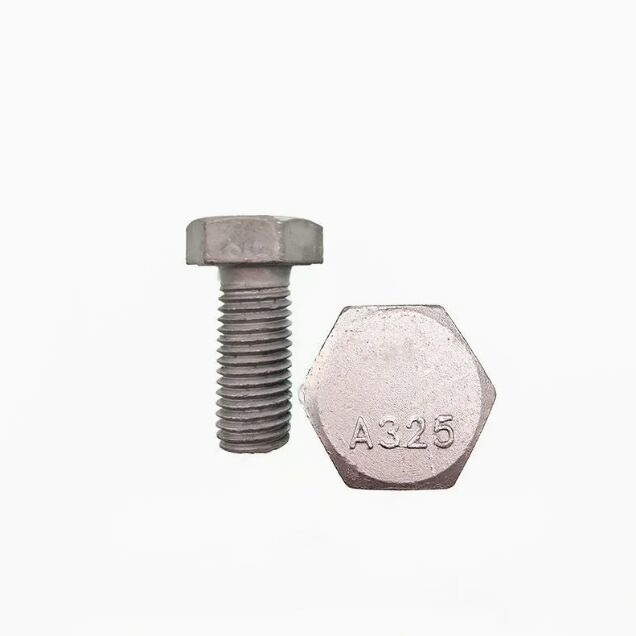Understanding the Role of A325 Bolts in Structural Engineering
Why A325 Bolts Are Critical for Load-Bearing Structures
A325 bolts hold critical importance in structural engineering work because they're built to handle intense stress situations, making sure buildings and other structures can support heavy loads safely. Engineers commonly specify these bolts for major construction jobs like bridges and skyscrapers where everything depends on solid connections that won't fail. According to guidelines from the American Institute of Steel Construction, sticking to proper technical specs is absolutely necessary when working with A325 bolts since their quality directly affects how safe and strong the whole structure remains over time. Following those standards isn't just about meeting regulations it actually makes a real difference in how well different parts of a building stay connected through years of use.
Key Properties: Tensile Strength and Durability
A325 bolts stand out for their impressive strength and long lasting nature, which is why they're often selected for serious structural work. Most of these bolts have at least 120 ksi tensile strength, making them capable of handling really heavy loads without failing. When it comes to how long structures last, durability matters a lot, and A325 bolts are built to withstand tough outdoor conditions year after year. For extra protection against rust and wear, various coatings and surface treatments can be added during manufacturing. These additions help the bolts last longer while keeping those important structural connections tight and dependable, even when exposed to weather or other challenging situations. All these characteristics together play a major role in maintaining safe and stable structures over their entire service life.
ASTM A325 Specifications and Technical Requirements
Material Composition: Medium Carbon vs. Weathering Steel
Most A325 bolts come from either medium carbon steel or weathering steel, materials that work better in different situations depending on what kind of environment they'll face. When there's not much risk of severe corrosion, medium carbon steel makes sense because it holds up well and doesn't break the budget. For projects outdoors where rain, snow, and sun take their toll, weathering steel becomes the go to choice since it stands up against atmospheric corrosion so much better. Knowing whether to pick one material over another really matters when building anything long lasting. The ASTM specs lay out all the details about how these materials should perform, which helps ensure that whatever gets built with A325 bolts will stand up to regular use without failing unexpectedly.
Dimensional Standards: Diameter, Length, and Thread Design
Getting the right dimensions for A325 bolts matters a lot when it comes to making sure they work properly in structural designs. These bolts need to fit well with all the other parts in a construction project. The size details matter too - most commonly, diameters run from half an inch up to one inch. Lengths vary depending on what's needed for each job, and the threads have specific measurements as well. All these factors determine where and how these bolts can be used. Good thread design makes installation easier while also affecting how strong and reliable the bolt will be once installed. Following ASTM standards for dimensions means these bolts actually perform as expected in real world conditions. When specs are met correctly, the bolts handle stress without failing, which keeps buildings and structures safe over time.
A325 vs. A490 Bolts: Comparing Structural Bolt Grades
Strength Differences: Tensile and Yield Capacities
When it comes to strength, A490 bolts really stand out from their A325 counterparts, especially when dealing with heavy loads or stress points. Take a look at the numbers: A490 bolts typically reach around 150 ksi minimum tensile strength, way beyond what we see in standard A325 bolts. That kind of power lets these bolts handle much bigger forces before showing any signs of deformation, something absolutely necessary for structures needing serious durability. Both types pass ASTM tests for strength standards, so quality isn't an issue here. Still, engineers need to think carefully about which one works best for each particular job site conditions matter a lot. Getting this right isn't just about following specs either the wrong choice could compromise whole structures down the road, no matter how small the component seems.
Applications: When to Use A325 vs. High-Strength A490
When it comes to standard structural work, A325 bolts tend to be what most engineers reach for because they work well across different situations and don't break the bank. They handle pretty much anything from everyday building frames right up to connecting parts of bridges where things aren't too intense. On the flip side, when faced with really tough jobs like constructing high rises or working on massive industrial equipment, contractors usually go with A490 bolts instead since those can take way more weight. Choosing between them depends on several factors including how much force needs to be handled, what kind of weather conditions will affect the project, and obviously money matters too. Most professionals know better than to just wing it though they always check the official specs and talk to experts before making final decisions about which bolt type makes sense for any particular job site.
Installation Best Practices for A325 Structural Bolts
Torque Requirements and Calibrated Wrench Methods
Getting the right amount of torque applied matters a lot when working with A325 structural bolts. The specs for how tight these bolts need to be are pretty clear cut if we want them to hold up properly. Calibrated wrenches make all the difference here since they help hit those exact numbers needed. Without proper calibration, there's always the risk of either not tightening enough or going too far. Not getting it right on the low end means joints might start slipping loose, whereas cranking things down too much just ends up damaging the bolts themselves. Industry folks know this well from experience. When torque standards get ignored, structures simply don't last as long as they should. So sticking to those torque figures and making sure tools are properly calibrated isn't just good practice it's what keeps buildings standing strong year after year.
Avoiding Common Errors: Over-Tightening and Misalignment
Installation mistakes happen all the time on job sites, especially with A325 bolts. When workers over tighten them, they risk cracking the bolts themselves or damaging surrounding materials. Misaligned bolts create stress points that can weaken connections across the whole structure. We've seen cases where these issues led to complete system failures down the road. The fix? Stick to basic best practices. Before assembly begins, check everything carefully for alignment issues. Use calibrated torque wrenches instead of guessing at how tight is too tight. Most specs call for around 80 foot-pounds for standard applications. Following manufacturer guidelines isn't just about ticking boxes for inspections either. Proper installation makes structures last longer and keeps everyone safer in the long run, something every contractor should care about beyond just meeting code requirements.
Complementary Hardware: Selecting Nuts and Washers
Choosing the Right Nuts for A325 Bolts (Including U Nuts)
Picking the right nuts for A325 bolts matters a lot if we want good results from our construction projects. There are several things worth considering when going through this process including thread sizes, what materials they're made from, and whether they actually meet those ASTM specifications everyone keeps talking about. Getting these details right helps unlock what A325 bolts can really do while keeping structural joints strong and reliable. Take U nuts for instance, these have their own special role in certain situations so engineers need to look closely at exactly what kind of job needs doing before settling on them. Following ASTM guidelines makes sense because it means we know the nuts will work together properly and hold up under stress. At the end of the day, sticking to these standards gives builders confidence that all those bolted connections will perform how they should during actual use conditions.
- Find matching nuts to meet A325 bolt specifications considering factors like thread size and material.
- Utilize U nuts application-specific functions.
- Adhere to ASTM standards to ensure nuts fully utilize the capacities of A325 bolts.
Why Proper Washers Matter for Load Distribution
Washers do more than just sit there between bolts and nuts. They help spread out the pressure so nothing gets pulled through, and keep everything stable when parts are bolted together. Getting the right kind matters a lot for how long things last. Flat washers work fine for most jobs, but sometimes lock washers or those bigger fender washers are needed depending on what's being fastened. Maintenance crews should check these little components regularly during inspections because they wear down over time. Skip this step and problems start showing up fast. Uneven pressure builds up, which eventually leads to bolts coming loose or breaking completely. We've seen it happen too many times in workshops where corners were cut on basic hardware selection.
- Ensure washers facilitate even load distribution, preventing bolt head pull-through.
- Different types of washers impacting performance include flat, lock, or fender washers.
- Regular inspection can ensure washers retain their protective functions.
In both sections, selecting the right complementary hardware enhances the overall strength and durability of A325 bolted configurations, adhering to industry standards for achieving reliable and robust structural connections.
FAQs
What are A325 bolts used for?
A325 bolts are used in structural engineering to withstand high-stress scenarios, making them critical for load-bearing structures like bridges and high-rise buildings.
What is the main difference between A325 and A490 bolts?
A490 bolts have a higher tensile strength compared to A325 bolts, making them suitable for more demanding, high-stress structural applications.
Why is torque application important for installing A325 bolts?
Torque application ensures that A325 bolts are neither under-tightened nor over-tightened, maintaining structural integrity and preventing joint slippage or bolt damage.
What role do washers play in bolted connections?
Washers help evenly distribute loads and prevent bolt head pull-through, enhancing the stability and longevity of bolted connections.
Why are material composition and dimensional standards significant for A325 bolts?
Material composition and dimensional standards ensure that A325 bolts perform effectively in specific environmental conditions and fit seamlessly into structural designs.

